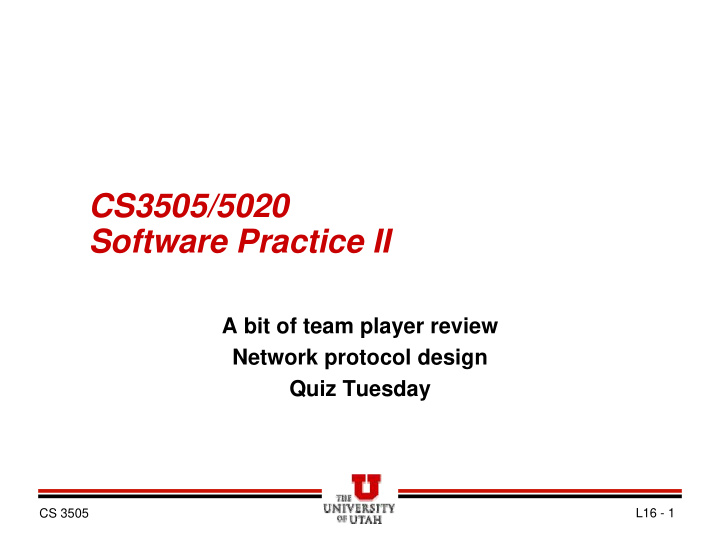



CS3505/5020 Software Practice II A bit of team player review Network protocol design Quiz Tuesday CS 3505 L16 - 1
Types Over the Years Contributor Collaborator Communicator Challenger Spring 07 26 18 12 11 Spring 08 27 17 9 10 Spring 09 23 13 11 10 Spring 10 30 26 7 12
The Four Team Player Styles � Contributor - task-oriented who enjoys providing the team with good technical information and data, does their homework, pushes team to set high performance standards and to use their resources wisely. Others view contributor as dependable – Dependable; Responsible; Organized; Efficient; Logical; Clear; Relevant; Pragmatic; Systematic; Proficient � Collaborator - goal-directed who sees the vision, mission, or goal of the team as paramount, but is flexible and open to new ideas, is willing to pitch in and work outside their defined role, and is able to share the limelight with other team members. Others view collaborator as “big-picture” person – Cooperative; Flexible; Confident; Forward-looking; Conceptual; Accommodating; Generous; Open; Visionary, Imaginative CS 3505
The Four Team Player Styles - 2 � Communicator - process-oriented who is an effective listener and facilitator of involvement, conflict resolution, consensus building, feedback, and the building of an informal, relaxed climate. Others see the communicator as a positive people person – Supportive; Encouraging; Relaxed; Tactful; Helpful; Friendly; Patient; Informal; Considerate; Spontaneous � Challenger - questions the goals, methods, and even the ethics of the team, is willing to disagree with the leader or higher authority, and encourages the team to take well-conceived risks. Others appreciate the value of the challenger’s candor and openness – Candid; Ethical; Questioning; Honest; Truthful; Outspoken; Principled; Adventurous; Aboveboard; Brave CS 3505
Winning design � Votes were tallied as follows: – 3 points for first place vote – 2 points for second place vote – 1 point for third place vote � More people voted for the winner than for any other design.
Winning design blue 61 teal 10 forestgreen 3 yellow 57 tomato 10 orange 3 cadetblue 43 cornsilk 9 silver 3 wheat 39 goldenrod 9 skyblue 3 chartreuse 38 khaki 8 tan 3 maroon 23 cyan 7 violet 3 hotpink 19 brown 6 aqua 2 firebrick 17 thistle 6 chatreuse 2 chocolate 15 bisque 5 fuschia 2 moccasin 15 fuchsia 5 springgreen 2 gold 13 aquamarine 4 turquoise 2 pink 13 cornflowerblue 4 burlywood 1 royalblue 13 magenta 4 cadet 1 deeppink 12 red 4 crimson 1 sienna 11 coral 3 saddlebrown 1 plum 10 dodgerblue 3
What did voting reveal? � What were student selection criteria? – Was the document legible / understandable? – Did the diagrams communicate what the prose was saying? – Was it presented well? – Concise, succinct? – Was it complete? – How were errors and abnormal situations handled? – Ease of implementation
What did voting reveal? � Was this just an academic exercise? – No! – There are two main activities in play: » Quality of the design » Quality of the presentation – It is often the case in industry that you will propose an idea that you want others to accept, to get ‘on board’. – Quality presentations will often translate directly into career success.
Blue summary � Lobby actions largely handled by XNA � Peer-to-peer game updates – Notion of a ‘latency adjustment frame’ that can be frequent or infrequent – Automatic latency adjustment – Latency adjustment frame defines an event window – Clients resend events since last latency frame with every data send – Clients never ‘request’ data – stalls cause data since last two event windows (latency frames) to be resent. – Huge data transmission overhead possible.
Blue – needed improvements � Dropped player consensus needs to be added. � Even in stalls, something must exist to prevent cascading drops. � OWD calculations need to be revisited to ensure all clients adjust latencies simultaneously. � Event packets need a ‘frame to apply to’ field.
Quiz #2 � Quiz will be on Tuesday – Similar to the first – one page of questions – Focus: UML Diagrams, team player styles » Interpret some UML diagrams – identify what is going on » State machines, activity, sequence, and class diagrams » For team player styles: Given a description of team behavior, classify it as one of the four team player types
Recommend
More recommend